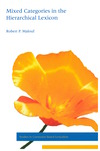

|
|
|
|

Mixed Categories in the Hierarchical LexiconMixed category constructions like the English verbal gerund involve words that seem to be central members of more that one part of speech and so pose a problem for the standard view of syntactic categories. This book presents a novel analysis of this and similar mixed category constructions in languages including Quechua, Tibetan, Arabic, Fijian, Dagaare, and Jacaltec. Under this analysis, verbal gerunds share the selectional properties of verbs and the distributional properties of nouns. Since different dimensions of grammatical information can vary independently, the behavior of mixed categories creates no paradox. But, while these dimensions are in principle independent, in fact certain types of mixed categories are quite common in the world's languages, while others are rare or nonexistent. The cross-linguistic variation can best be accounted for by means of a lexical categorial prototype. Specifically, nouns prototypically denote objects and verbs prototypically denote actions. By stating these prototypes as default constraints in a hierarchy of lexical information, we can bring insights from cognitive and functional approaches to linguistics into a formal analysis, thus building on the strengths of both approaches. was a post-doctoral researcher in the Department of Humanities Computing, University of Groningen, The Netherlands. Contents
8/15/2000 ISBN (Paperback): 1575861909 (9781575861906)
Subject: Linguistics; Grammatical Categories; Grammar--Syntax |
Distributed by the
University of Chicago Press |
|
pubs @ csli.stanford.edu
|
CSLI Publications
Stanford University Cordura Hall 210 Panama Street Stanford, CA 94305-4101 (650) 723-1839 |